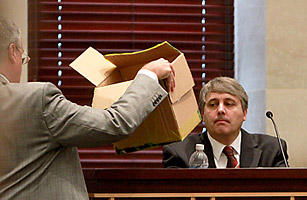
Millions of viewers have been transfixed by the parade of forensic experts presented by the prosecution over the last few weeks in the trial of Casey Anthony, a 25 year-old mother who stands accused of killing her two year-old daughter Caylee and dumping the child’s body near their Orange County, Florida home in 2008. The ubiquitous broadcasts of the trial are as compelling as anything that fans of the fictional forensics drama, CSI: Miami, might encounter. But the cutting-edge crime scene science is far more technical, inexact and contradictory than anything a screenwriter might gin up. And it’s just those contradictions that the defense will point out as they take center stage this week.
To find out how Anthony’s lawyers might rebut the most damaging prosecution evidence, TIME asked crime experts to weigh in on the viability of the seven most important aspects of the forensic testimony so far. 1. Evidence “Consistent” With a Crime Does Not Constitute Proof
On TV, forensic scientists usually emerge from the lab with proof of a killer’s identity. DNA, fibers, hair samples and a host of other evidence always seem to point fictional cops right to the culprit.
But in reality, it’s not usually about one hair sample. In the Anthony case, the prosecution has attempted to show that the forensic evidence they’ve gathered is “consistent with” their theory of how Caylee was killed. Prosecutors allege that Anthony conducted Internet searches for making chloroform, that she used the homemade chemical to knock her daughter out, that she put duct tape over Caylee’s mouth and nose, and then she dumped her daughter’s body in the woods. Many of the experts in the case so far have testified that the evidence they’ve seen is “consistent” with these assertions.
But consistency is not as powerful in court as presenting evidence that points directly to the identity of a killer, explains Dr. Adina Schwartz, an expert in evidence law and science and a professor of law and philosophy at the John Jay College of Criminal Justice, City University of New York. “What does ‘consistent with’ mean? It means ‘could be,'” Schwartz explains. That uncertainty will create room for the defense to make its case. 2. Identifying Human Hairs Isn’t an Exact Science
According to the prosecution’s narrative, Anthony stored the body of her daughter in the trunk of her car after subduing the little girl with chloroform.
Investigators discovered hairs in the trunk, which they tested for DNA. This is the part of the TV plot where we learn who owned those hairs. In reality, DNA testing only narrowed the identity. Because the hairs they found, contained no roots or tissue, investigators could only test for mitochondrial DNA, which is passed down through female ancestors. This means that the hairs could belong to as many as five people: Casey, her mother and grandmother, Casey’s brother and finally Caylee.
“They cannot say with scientific certainty that it’s Caylee’s, although it’s suggestive that it’s Caylee’s,” Dr. Lawrence Kobilinsky, a DNA expert and head of the Forensic Sciences department at John Jay College, explains about the hairs.